Paper Menu >>
Journal Menu >>
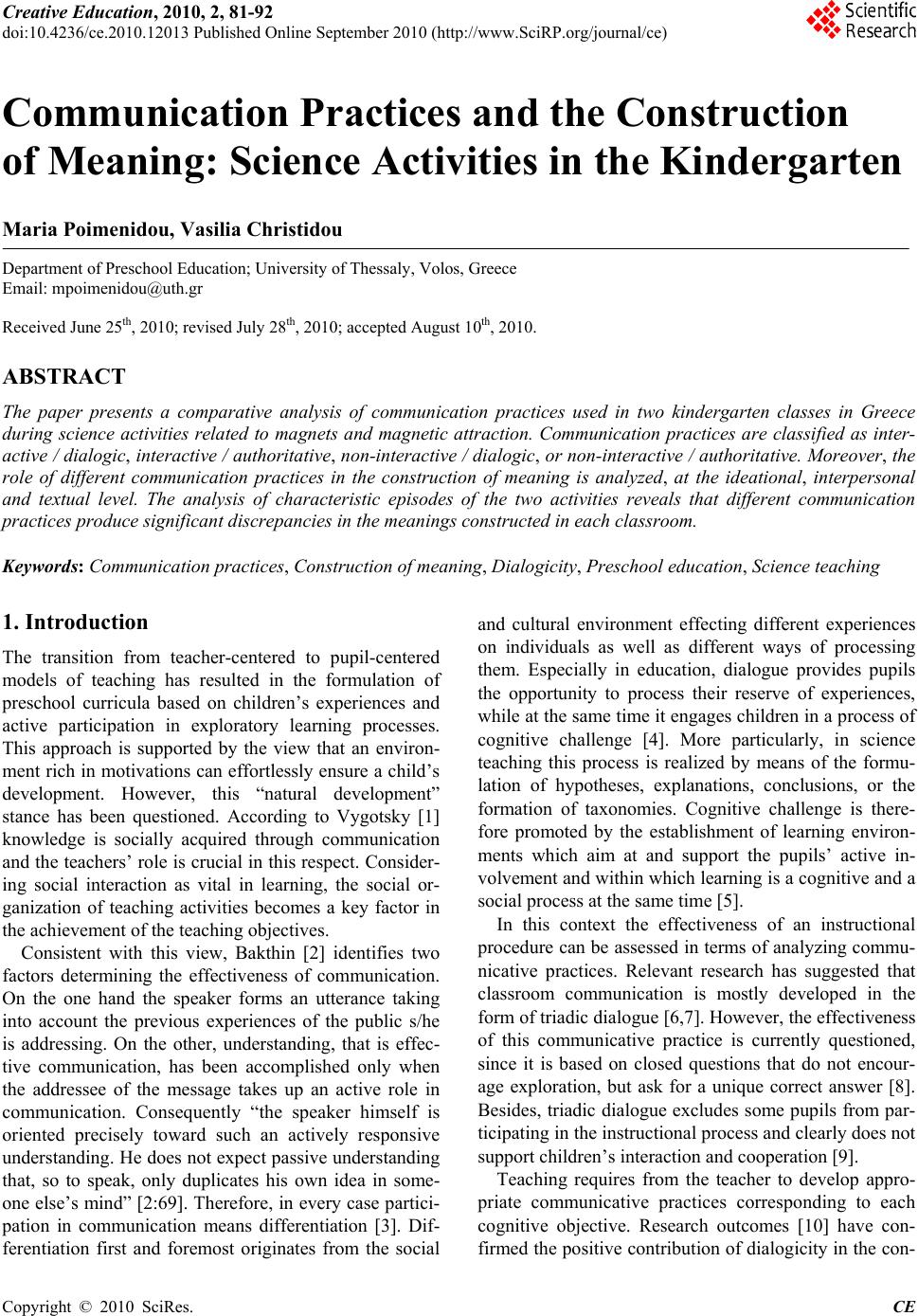 Creative Education, 2010, 2, 81-92 doi:10.4236/ce.2010.12013 Published Online September 2010 (http://www.SciRP.org/journal/ce) Copyright © 2010 SciRes. CE 81 Communication Practices and the Construction of Meaning: Science Activities in the Kindergarten Maria Poimenidou, Vasilia Christidou Department of Preschool Education; University of Thessaly, Volos, Greece Email: mpoimenidou@uth.gr Received June 25th, 2010; revised July 28th, 2010; accepted August 10th, 2010. ABSTRACT The paper presents a comparative analysis of communication practices used in two kindergarten classes in Greece during science activities related to magnets and magnetic attraction. Communication practices are classified as inter- active / dialogic, interactive / authoritative, non-interactive / dialogic, or non-interactive / authoritative. Moreover, the role of different communication practices in the construction of meaning is analyzed, at the ideational, interpersonal and textual level. The analysis of characteristic episodes of the two activities reveals that different communication practices produce significant discrepancies in the meanings constructed in each classroom. Keywords: Communication practices, Construction of meaning, Dialogicity, Preschool education, Science teaching 1. Introduction The transition from teacher-centered to pupil-centered models of teaching has resulted in the formulation of preschool curricula based on children’s experiences and active participation in exploratory learning processes. This approach is supported by the view that an environ- ment rich in motivations can effortlessly ensure a child’s development. However, this “natural development” stance has been questioned. According to Vygotsky [1] knowledge is socially acquired through communication and the teachers’ role is crucial in this respect. Consider- ing social interaction as vital in learning, the social or- ganization of teaching activities becomes a key factor in the achievement of the teaching objectives. Consistent with this view, Bakthin [2] identifies two factors determining the effectiveness of communication. On the one hand the speaker forms an utterance taking into account the previous experiences of the public s/he is addressing. On the other, understanding, that is effec- tive communication, has been accomplished only when the addressee of the message takes up an active role in communication. Consequently “the speaker himself is oriented precisely toward such an actively responsive understanding. He does not expect passive understanding that, so to speak, only duplicates his own idea in some- one else’s mind” [2:69]. Therefore, in every case partici- pation in communication means differentiation [3]. Dif- ferentiation first and foremost originates from the social and cultural environment effecting different experiences on individuals as well as different ways of processing them. Especially in education, dialogue provides pupils the opportunity to process their reserve of experiences, while at the same time it engages children in a process of cognitive challenge [4]. More particularly, in science teaching this process is realized by means of the formu- lation of hypotheses, explanations, conclusions, or the formation of taxonomies. Cognitive challenge is there- fore promoted by the establishment of learning environ- ments which aim at and support the pupils’ active in- volvement and within which learning is a cognitive and a social process at the same time [5]. In this context the effectiveness of an instructional procedure can be assessed in terms of analyzing commu- nicative practices. Relevant research has suggested that classroom communication is mostly developed in the form of triadic dialogue [6,7]. However, the effectiveness of this communicative practice is currently questioned, since it is based on closed questions that do not encour- age exploration, but ask for a unique correct answer [8]. Besides, triadic dialogue excludes some pupils from par- ticipating in the instructional process and clearly does not support children’s interaction and cooperation [9]. Teaching requires from the teacher to develop appro- priate communicative practices corresponding to each cognitive objective. Research outcomes [10] have con- firmed the positive contribution of dialogicity in the con- 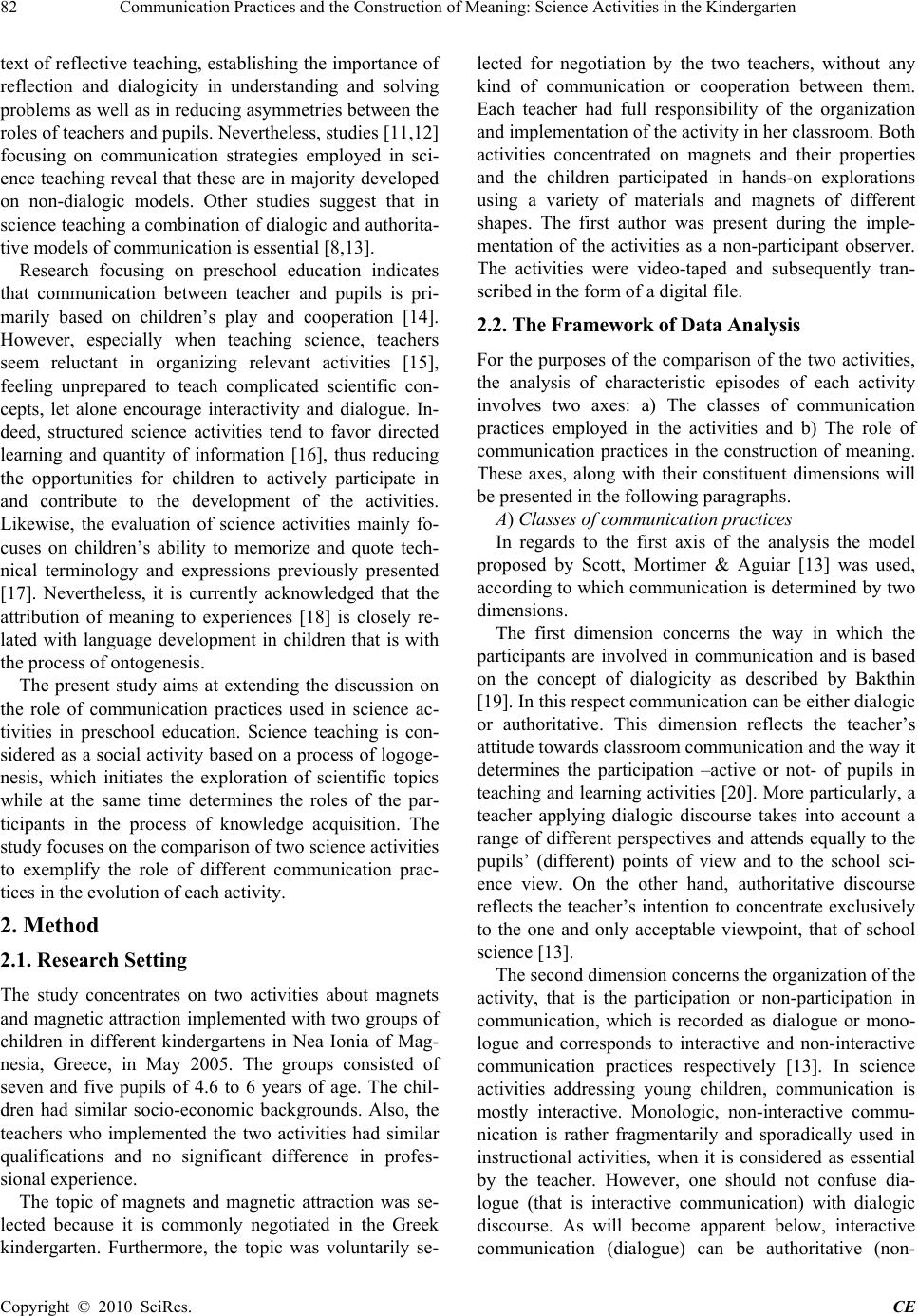 Communication Practices and the Construction of Meaning: Science Activities in the Kindergarten Copyright © 2010 SciRes. CE 82 text of reflective teaching, establishing the importance of reflection and dialogicity in understanding and solving problems as well as in reducing asymmetries between the roles of teachers and pupils. Nevertheless, studies [11,12] focusing on communication strategies employed in sci- ence teaching reveal that these are in majority developed on non-dialogic models. Other studies suggest that in science teaching a combination of dialogic and authorita- tive models of communication is essential [8,13]. Research focusing on preschool education indicates that communication between teacher and pupils is pri- marily based on children’s play and cooperation [14]. However, especially when teaching science, teachers seem reluctant in organizing relevant activities [15], feeling unprepared to teach complicated scientific con- cepts, let alone encourage interactivity and dialogue. In- deed, structured science activities tend to favor directed learning and quantity of information [16], thus reducing the opportunities for children to actively participate in and contribute to the development of the activities. Likewise, the evaluation of science activities mainly fo- cuses on children’s ability to memorize and quote tech- nical terminology and expressions previously presented [17]. Nevertheless, it is currently acknowledged that the attribution of meaning to experiences [18] is closely re- lated with language development in children that is with the process of ontogenesis. The present study aims at extending the discussion on the role of communication practices used in science ac- tivities in preschool education. Science teaching is con- sidered as a social activity based on a process of logoge- nesis, which initiates the exploration of scientific topics while at the same time determines the roles of the par- ticipants in the process of knowledge acquisition. The study focuses on the comparison of two science activities to exemplify the role of different communication prac- tices in the evolution of each activity. 2. Method 2.1. Research Setting The study concentrates on two activities about magnets and magnetic attraction implemented with two groups of children in different kindergartens in Nea Ionia of Mag- nesia, Greece, in May 2005. The groups consisted of seven and five pupils of 4.6 to 6 years of age. The chil- dren had similar socio-economic backgrounds. Also, the teachers who implemented the two activities had similar qualifications and no significant difference in profes- sional experience. The topic of magnets and magnetic attraction was se- lected because it is commonly negotiated in the Greek kindergarten. Furthermore, the topic was voluntarily se- lected for negotiation by the two teachers, without any kind of communication or cooperation between them. Each teacher had full responsibility of the organization and implementation of the activity in her classroom. Both activities concentrated on magnets and their properties and the children participated in hands-on explorations using a variety of materials and magnets of different shapes. The first author was present during the imple- mentation of the activities as a non-participant observer. The activities were video-taped and subsequently tran- scribed in the form of a digital file. 2.2. The Framework of Data Analysis For the purposes of the comparison of the two activities, the analysis of characteristic episodes of each activity involves two axes: a) The classes of communication practices employed in the activities and b) The role of communication practices in the construction of meaning. These axes, along with their constituent dimensions will be presented in the following paragraphs. A) Classes of communication practices In regards to the first axis of the analysis the model proposed by Scott, Mortimer & Aguiar [13] was used, according to which communication is determined by two dimensions. The first dimension concerns the way in which the participants are involved in communication and is based on the concept of dialogicity as described by Bakthin [19]. In this respect communication can be either dialogic or authoritative. This dimension reflects the teacher’s attitude towards classroom communication and the way it determines the participation –active or not- of pupils in teaching and learning activities [20]. More particularly, a teacher applying dialogic discourse takes into account a range of different perspectives and attends equally to the pupils’ (different) points of view and to the school sci- ence view. On the other hand, authoritative discourse reflects the teacher’s intention to concentrate exclusively to the one and only acceptable viewpoint, that of school science [13]. The second dimension concerns the organization of the activity, that is the participation or non-participation in communication, which is recorded as dialogue or mono- logue and corresponds to interactive and non-interactive communication practices respectively [13]. In science activities addressing young children, communication is mostly interactive. Monologic, non-interactive commu- nication is rather fragmentarily and sporadically used in instructional activities, when it is considered as essential by the teacher. However, one should not confuse dia- logue (that is interactive communication) with dialogic discourse. As will become apparent below, interactive communication (dialogue) can be authoritative (non- 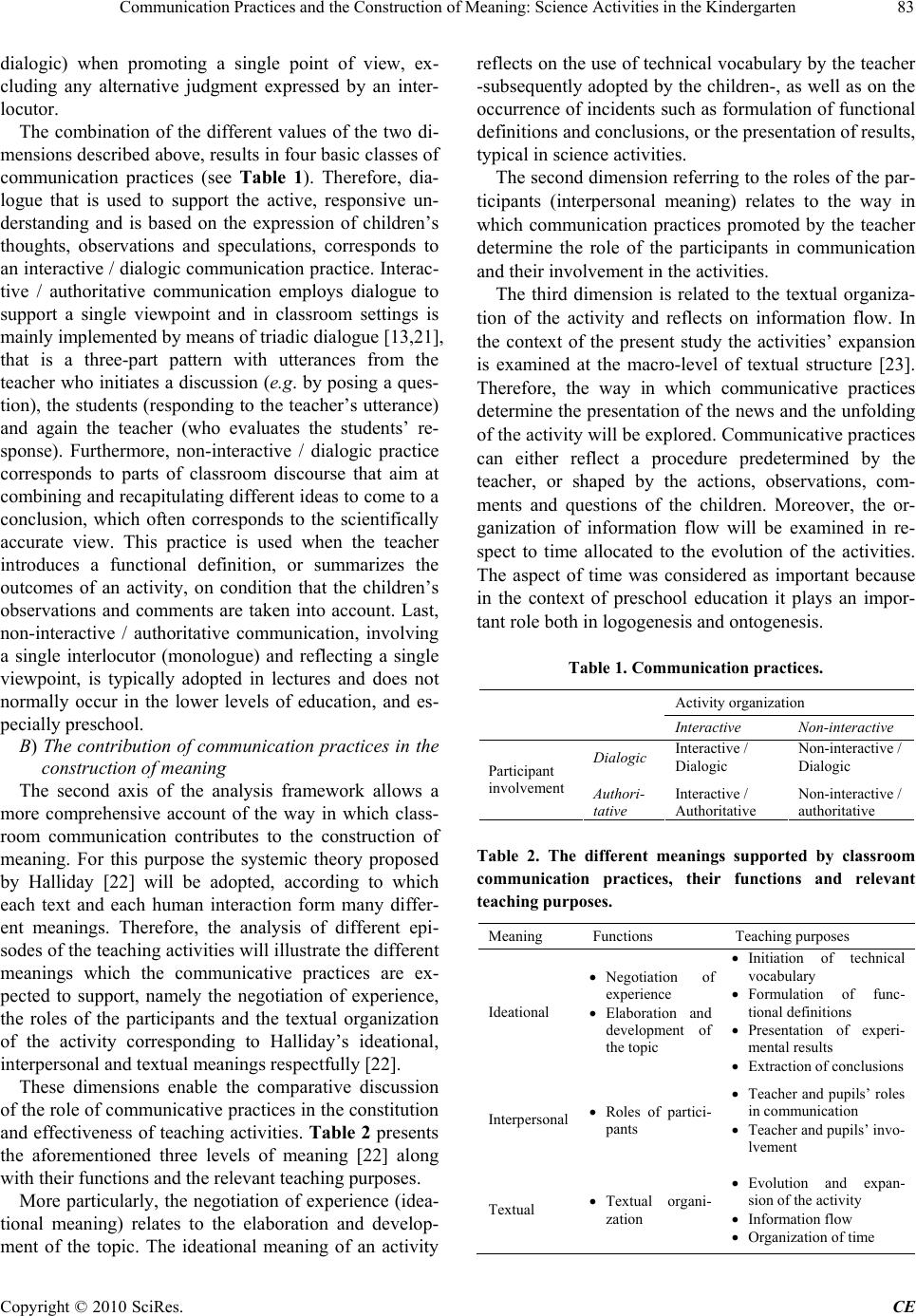 Communication Practices and the Construction of Meaning: Science Activities in the Kindergarten Copyright © 2010 SciRes. CE 83 dialogic) when promoting a single point of view, ex- cluding any alternative judgment expressed by an inter- locutor. The combination of the different values of the two di- mensions described above, results in four basic classes of communication practices (see Table 1). Therefore, dia- logue that is used to support the active, responsive un- derstanding and is based on the expression of children’s thoughts, observations and speculations, corresponds to an interactive / dialogic communication practice. Interac- tive / authoritative communication employs dialogue to support a single viewpoint and in classroom settings is mainly implemented by means of triadic dialogue [13,21], that is a three-part pattern with utterances from the teacher who initiates a discussion (e.g. by posing a ques- tion), the students (responding to the teacher’s utterance) and again the teacher (who evaluates the students’ re- sponse). Furthermore, non-interactive / dialogic practice corresponds to parts of classroom discourse that aim at combining and recapitulating different ideas to come to a conclusion, which often corresponds to the scientifically accurate view. This practice is used when the teacher introduces a functional definition, or summarizes the outcomes of an activity, on condition that the children’s observations and comments are taken into account. Last, non-interactive / authoritative communication, involving a single interlocutor (monologue) and reflecting a single viewpoint, is typically adopted in lectures and does not normally occur in the lower levels of education, and es- pecially preschool. B) The contribution of communication practices in the construction of meaning The second axis of the analysis framework allows a more comprehensive account of the way in which class- room communication contributes to the construction of meaning. For this purpose the systemic theory proposed by Halliday [22] will be adopted, according to which each text and each human interaction form many differ- ent meanings. Therefore, the analysis of different epi- sodes of the teaching activities will illustrate the different meanings which the communicative practices are ex- pected to support, namely the negotiation of experience, the roles of the participants and the textual organization of the activity corresponding to Halliday’s ideational, interpersonal and textual meanings respectfully [22]. These dimensions enable the comparative discussion of the role of communicative practices in the constitution and effectiveness of teaching activities. Table 2 presents the aforementioned three levels of meaning [22] along with their functions and the relevant teaching purposes. More particularly, the negotiation of experience (idea- tional meaning) relates to the elaboration and develop- ment of the topic. The ideational meaning of an activity reflects on the use of technical vocabulary by the teacher -subsequently adopted by the children-, as well as on the occurrence of incidents such as formulation of functional definitions and conclusions, or the presentation of results, typical in science activities. The second dimension referring to the roles of the par- ticipants (interpersonal meaning) relates to the way in which communication practices promoted by the teacher determine the role of the participants in communication and their involvement in the activities. The third dimension is related to the textual organiza- tion of the activity and reflects on information flow. In the context of the present study the activities’ expansion is examined at the macro-level of textual structure [23]. Therefore, the way in which communicative practices determine the presentation of the news and the unfolding of the activity will be explored. Communicative practices can either reflect a procedure predetermined by the teacher, or shaped by the actions, observations, com- ments and questions of the children. Moreover, the or- ganization of information flow will be examined in re- spect to time allocated to the evolution of the activities. The aspect of time was considered as important because in the context of preschool education it plays an impor- tant role both in logogenesis and ontogenesis. Table 1. Communication practices. Activity organization Interactive Non-interactive Dialogic Interactive / Dialogic Non-interactive / Dialogic Participant involvement Authori- tative Interactive / Authoritative Non-interactive / authoritative Table 2. The different meanings supported by classroom communication practices, their functions and relevant teaching purposes. Meaning Functions Teaching purposes Ideational Negotiation of experience Elaboration and development of the topic Initiation of technical vocabulary Formulation of func- tional definitions Presentation of experi- mental results Extraction of conclusions Interpersonal Roles of partici- pants Teacher and pupils’ roles in communication Teacher and pupils’ invo- lvement Textual Textual organi- zation Evolution and expan- sion of the activity Information flow Organization of time 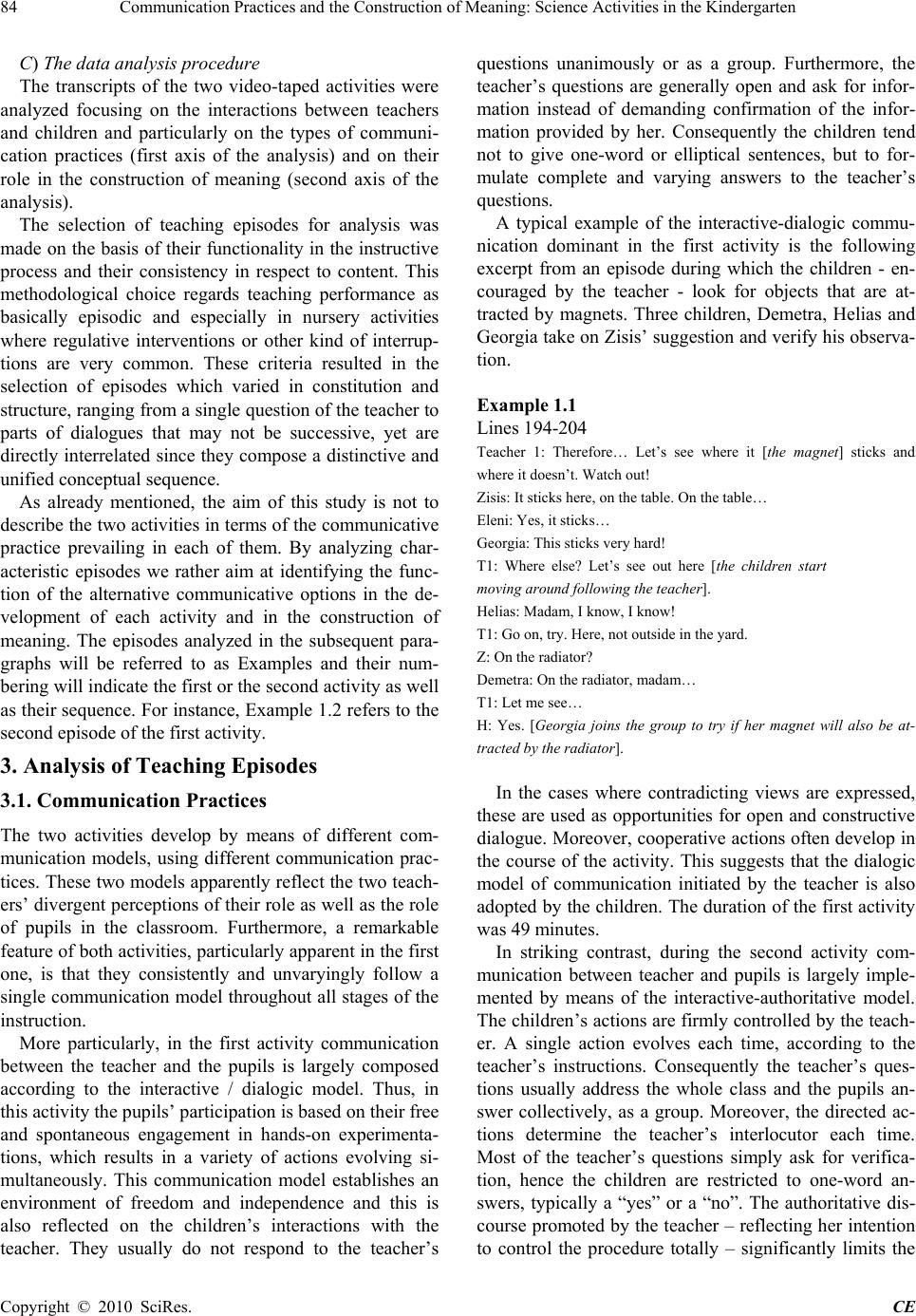 Communication Practices and the Construction of Meaning: Science Activities in the Kindergarten Copyright © 2010 SciRes. CE 84 C) The data analysis procedure The transcripts of the two video-taped activities were analyzed focusing on the interactions between teachers and children and particularly on the types of communi- cation practices (first axis of the analysis) and on their role in the construction of meaning (second axis of the analysis). The selection of teaching episodes for analysis was made on the basis of their functionality in the instructive process and their consistency in respect to content. This methodological choice regards teaching performance as basically episodic and especially in nursery activities where regulative interventions or other kind of interrup- tions are very common. These criteria resulted in the selection of episodes which varied in constitution and structure, ranging from a single question of the teacher to parts of dialogues that may not be successive, yet are directly interrelated since they compose a distinctive and unified conceptual sequence. As already mentioned, the aim of this study is not to describe the two activities in terms of the communicative practice prevailing in each of them. By analyzing char- acteristic episodes we rather aim at identifying the func- tion of the alternative communicative options in the de- velopment of each activity and in the construction of meaning. The episodes analyzed in the subsequent para- graphs will be referred to as Examples and their num- bering will indicate the first or the second activity as well as their sequence. For instance, Example 1.2 refers to the second episode of the first activity. 3. Analysis of Teaching Episodes 3.1. Communication Practices The two activities develop by means of different com- munication models, using different communication prac- tices. These two models apparently reflect the two teach- ers’ divergent perceptions of their role as well as the role of pupils in the classroom. Furthermore, a remarkable feature of both activities, particularly apparent in the first one, is that they consistently and unvaryingly follow a single communication model throughout all stages of the instruction. More particularly, in the first activity communication between the teacher and the pupils is largely composed according to the interactive / dialogic model. Thus, in this activity the pupils’ participation is based on their free and spontaneous engagement in hands-on experimenta- tions, which results in a variety of actions evolving si- multaneously. This communication model establishes an environment of freedom and independence and this is also reflected on the children’s interactions with the teacher. They usually do not respond to the teacher’s questions unanimously or as a group. Furthermore, the teacher’s questions are generally open and ask for infor- mation instead of demanding confirmation of the infor- mation provided by her. Consequently the children tend not to give one-word or elliptical sentences, but to for- mulate complete and varying answers to the teacher’s questions. A typical example of the interactive-dialogic commu- nication dominant in the first activity is the following excerpt from an episode during which the children - en- couraged by the teacher - look for objects that are at- tracted by magnets. Three children, Demetra, Helias and Georgia take on Zisis’ suggestion and verify his observa- tion. Example 1.1 Lines 194-204 Teacher 1: Therefore… Let’s see where it [the magnet] sticks and where it doesn’t. Watch out! Zisis: It sticks here, on the table. On the table… Eleni: Yes, it sticks… Georgia: This sticks very hard! T1: Where else? Let’s see out here [the children start moving around following the teacher]. Helias: Madam, I know, I know! T1: Go on, try. Here, not outside in the yard. Z: On the radiator? Demetra: On the radiator, madam… T1: Let me see… H: Yes. [Georgia joins the group to try if her magnet will also be at- tracted by the radiator]. In the cases where contradicting views are expressed, these are used as opportunities for open and constructive dialogue. Moreover, cooperative actions often develop in the course of the activity. This suggests that the dialogic model of communication initiated by the teacher is also adopted by the children. The duration of the first activity was 49 minutes. In striking contrast, during the second activity com- munication between teacher and pupils is largely imple- mented by means of the interactive-authoritative model. The children’s actions are firmly controlled by the teach- er. A single action evolves each time, according to the teacher’s instructions. Consequently the teacher’s ques- tions usually address the whole class and the pupils an- swer collectively, as a group. Moreover, the directed ac- tions determine the teacher’s interlocutor each time. Most of the teacher’s questions simply ask for verifica- tion, hence the children are restricted to one-word an- swers, typically a “yes” or a “no”. The authoritative dis- course promoted by the teacher – reflecting her intention to control the procedure totally – significantly limits the 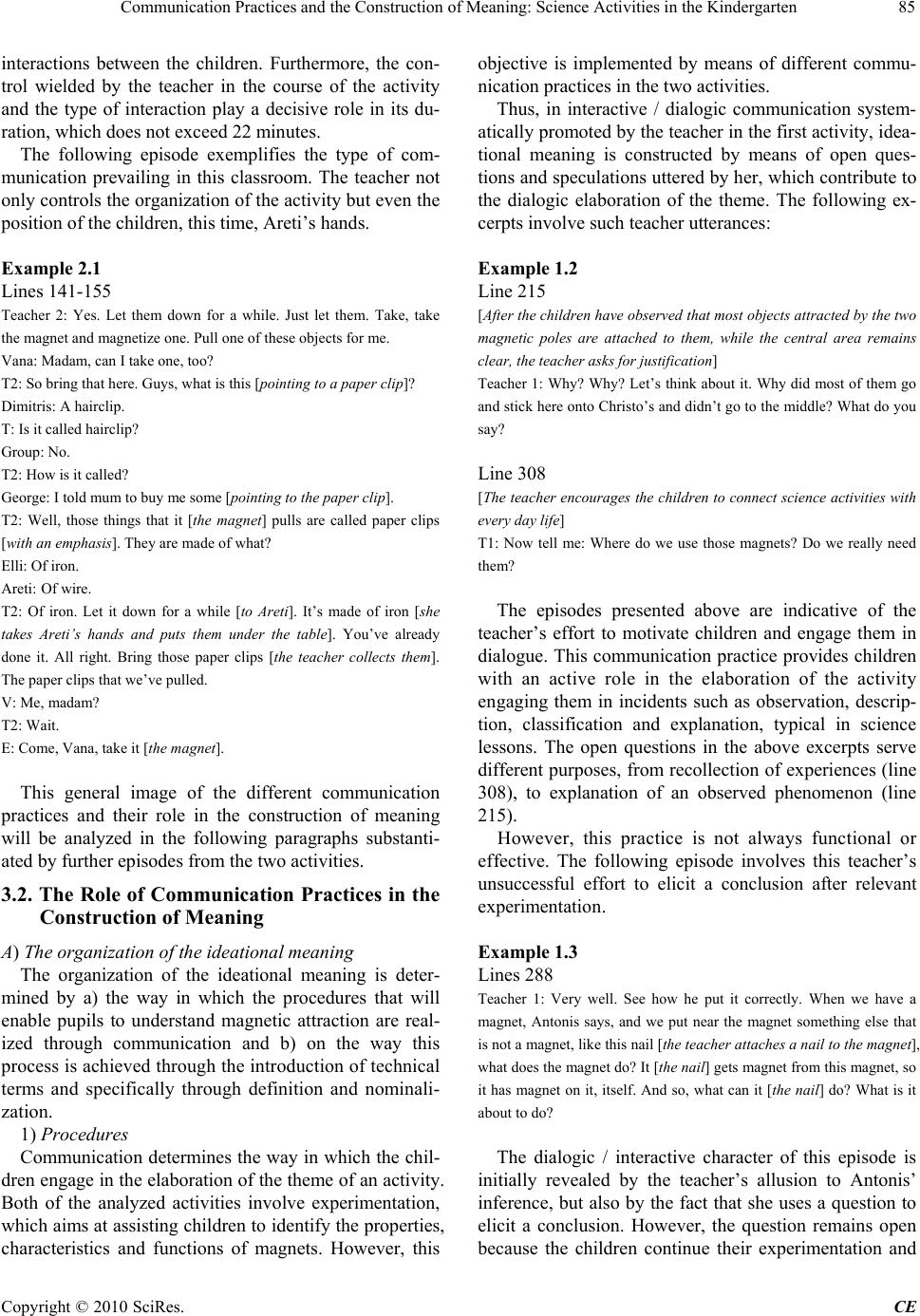 Communication Practices and the Construction of Meaning: Science Activities in the Kindergarten Copyright © 2010 SciRes. CE 85 interactions between the children. Furthermore, the con- trol wielded by the teacher in the course of the activity and the type of interaction play a decisive role in its du- ration, which does not exceed 22 minutes. The following episode exemplifies the type of com- munication prevailing in this classroom. The teacher not only controls the organization of the activity but even the position of the children, this time, Areti’s hands. Example 2.1 Lines 141-155 Teacher 2: Yes. Let them down for a while. Just let them. Take, take the magnet and magnetize one. Pull one of these objects for me. Vana: Madam, can I take one, too? T2: So bring that here. Guys, what is this [pointing to a paper clip]? Dimitris: A hairclip. T: Is it called hairclip? Group: No. T2: How is it called? George: I told mum to buy me some [pointing to the paper clip]. T2: Well, those things that it [the magnet] pulls are called paper clips [with an emphasis]. They are made of what? Elli: Of iron. Areti: Of wire. T2: Of iron. Let it down for a while [to Areti]. It’s made of iron [she takes Areti’s hands and puts them under the table]. You’ve already done it. All right. Bring those paper clips [the teacher collects them]. The paper clips that we’ve pulled. V: Me, madam? T2: Wait. Ε: Come, Vana, take it [the magnet]. This general image of the different communication practices and their role in the construction of meaning will be analyzed in the following paragraphs substanti- ated by further episodes from the two activities. 3.2. The Role of Communication Practices in the Construction of Meaning A) The organization of the ideational meaning The organization of the ideational meaning is deter- mined by a) the way in which the procedures that will enable pupils to understand magnetic attraction are real- ized through communication and b) on the way this process is achieved through the introduction of technical terms and specifically through definition and nominali- zation. 1) Procedures Communication determines the way in which the chil- dren engage in the elaboration of the theme of an activity. Both of the analyzed activities involve experimentation, which aims at assisting children to identify the properties, characteristics and functions of magnets. However, this objective is implemented by means of different commu- nication practices in the two activities. Thus, in interactive / dialogic communication system- atically promoted by the teacher in the first activity, idea- tional meaning is constructed by means of open ques- tions and speculations uttered by her, which contribute to the dialogic elaboration of the theme. The following ex- cerpts involve such teacher utterances: Example 1.2 Line 215 [After the children have observed that most objects attracted by the two magnetic poles are attached to them, while the central area remains clear, the teacher asks for justification] Teacher 1: Why? Why? Let’s think about it. Why did most of them go and stick here onto Christo’s and didn’t go to the middle? What do you say? Line 308 [The teacher encourages the children to connect science activities with every day life] T1: Now tell me: Where do we use those magnets? Do we really need them? The episodes presented above are indicative of the teacher’s effort to motivate children and engage them in dialogue. This communication practice provides children with an active role in the elaboration of the activity engaging them in incidents such as observation, descrip- tion, classification and explanation, typical in science lessons. The open questions in the above excerpts serve different purposes, from recollection of experiences (line 308), to explanation of an observed phenomenon (line 215). However, this practice is not always functional or effective. The following episode involves this teacher’s unsuccessful effort to elicit a conclusion after relevant experimentation. Example 1.3 Lines 288 Teacher 1: Very well. See how he put it correctly. When we have a magnet, Antonis says, and we put near the magnet something else that is not a magnet, like this nail [the teacher attaches a nail to the magnet], what does the magnet do? It [the nail] gets magnet from this magnet, so it has magnet on it, itself. And so, what can it [the nail] do? What is it about to do? The dialogic / interactive character of this episode is initially revealed by the teacher’s allusion to Antonis’ inference, but also by the fact that she uses a question to elicit a conclusion. However, the question remains open because the children continue their experimentation and 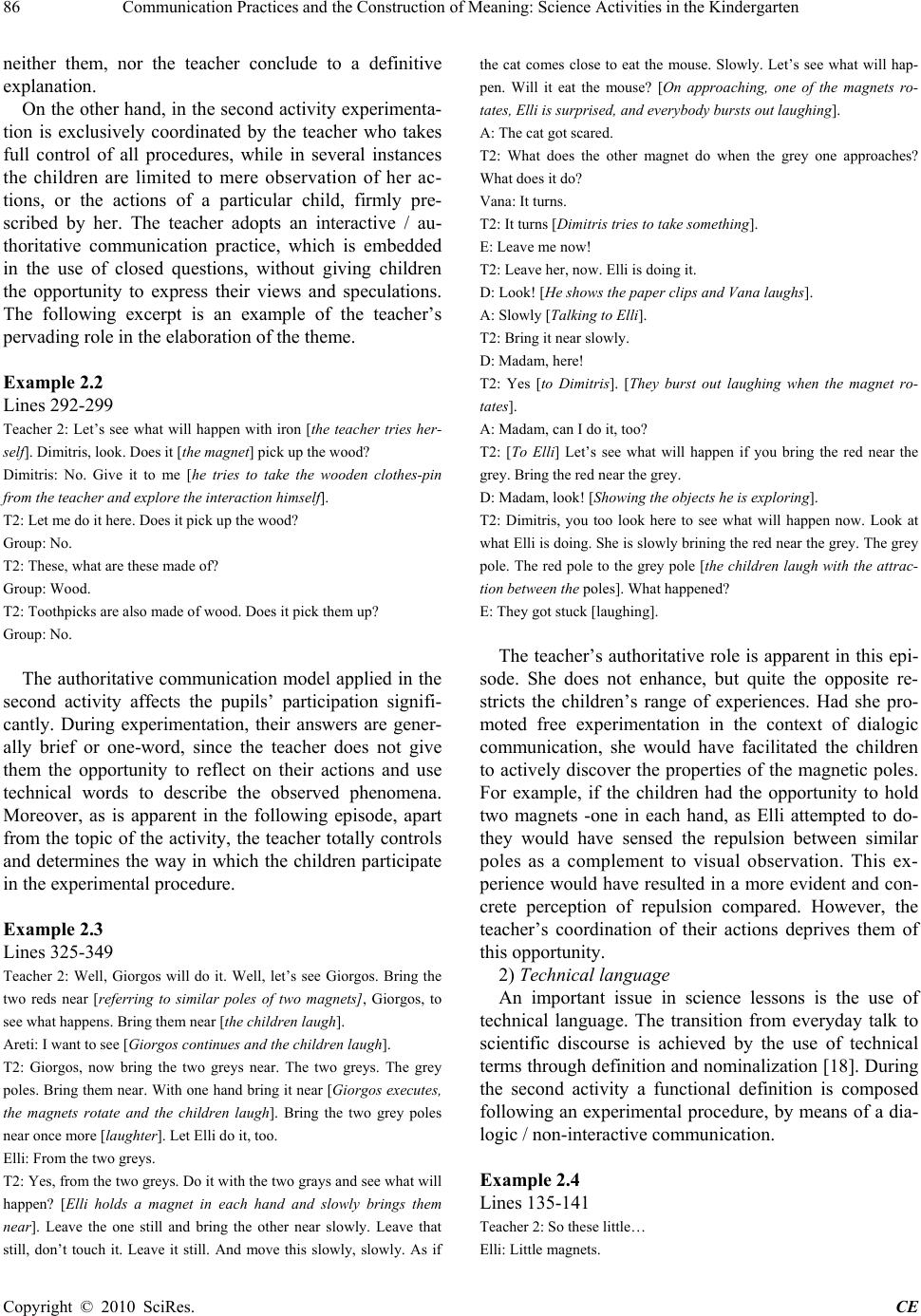 Communication Practices and the Construction of Meaning: Science Activities in the Kindergarten Copyright © 2010 SciRes. CE 86 neither them, nor the teacher conclude to a definitive explanation. On the other hand, in the second activity experimenta- tion is exclusively coordinated by the teacher who takes full control of all procedures, while in several instances the children are limited to mere observation of her ac- tions, or the actions of a particular child, firmly pre- scribed by her. The teacher adopts an interactive / au- thoritative communication practice, which is embedded in the use of closed questions, without giving children the opportunity to express their views and speculations. The following excerpt is an example of the teacher’s pervading role in the elaboration of the theme. Example 2.2 Lines 292-299 Teacher 2: Let’s see what will happen with iron [the teacher tries her- self]. Dimitris, look. Does it [the magnet] pick up the wood? Dimitris: No. Give it to me [he tries to take the wooden clothes-pin from the teacher and explore the interaction himself]. T2: Let me do it here. Does it pick up the wood? Group: No. T2: These, what are these made of? Group: Wood. T2: Toothpicks are also made of wood. Does it pick them up? Group: No. The authoritative communication model applied in the second activity affects the pupils’ participation signifi- cantly. During experimentation, their answers are gener- ally brief or one-word, since the teacher does not give them the opportunity to reflect on their actions and use technical words to describe the observed phenomena. Moreover, as is apparent in the following episode, apart from the topic of the activity, the teacher totally controls and determines the way in which the children participate in the experimental procedure. Example 2.3 Lines 325-349 Teacher 2: Well, Giorgos will do it. Well, let’s see Giorgos. Bring the two reds near [referring to similar poles of two magnets], Giorgos, to see what happens. Bring them near [the children laugh]. Areti: I want to see [Giorgos continues and the children laugh]. T2: Giorgos, now bring the two greys near. The two greys. The grey poles. Bring them near. With one hand bring it near [Giorgos executes, the magnets rotate and the children laugh]. Bring the two grey poles near once more [laughter]. Let Elli do it, too. Elli: From the two greys. T2: Yes, from the two greys. Do it with the two grays and see what will happen? [Elli holds a magnet in each hand and slowly brings them near]. Leave the one still and bring the other near slowly. Leave that still, don’t touch it. Leave it still. And move this slowly, slowly. As if the cat comes close to eat the mouse. Slowly. Let’s see what will hap- pen. Will it eat the mouse? [On approaching, one of the magnets ro- tates, Elli is surprised, and everybody bursts out laughing]. Α: The cat got scared. T2: What does the other magnet do when the grey one approaches? What does it do? Vana: It turns. T2: It turns [Dimitris tries to take something]. E: Leave me now! T2: Leave her, now. Elli is doing it. D: Look! [He shows the paper clips and Vana laughs]. Α: Slowly [Talking to Elli]. T2: Bring it near slowly. D: Madam, here! T2: Yes [to Dimitris]. [They burst out laughing when the magnet ro- tates]. Α: Madam, can I do it, too? T2: [To Elli] Let’s see what will happen if you bring the red near the grey. Bring the red near the grey. D: Madam, look! [Showing the objects he is exploring]. T2: Dimitris, you too look here to see what will happen now. Look at what Elli is doing. She is slowly brining the red near the grey. The grey pole. The red pole to the grey pole [the children laugh with the attrac- tion between the poles]. What happened? E: They got stuck [laughing]. The teacher’s authoritative role is apparent in this epi- sode. She does not enhance, but quite the opposite re- stricts the children’s range of experiences. Had she pro- moted free experimentation in the context of dialogic communication, she would have facilitated the children to actively discover the properties of the magnetic poles. For example, if the children had the opportunity to hold two magnets -one in each hand, as Elli attempted to do- they would have sensed the repulsion between similar poles as a complement to visual observation. This ex- perience would have resulted in a more evident and con- crete perception of repulsion compared. However, the teacher’s coordination of their actions deprives them of this opportunity. 2) Technical language An important issue in science lessons is the use of technical language. The transition from everyday talk to scientific discourse is achieved by the use of technical terms through definition and nominalization [18]. During the second activity a functional definition is composed following an experimental procedure, by means of a dia- logic / non-interactive communication. Example 2.4 Lines 135-141 Teacher 2: So these little… Elli: Little magnets. 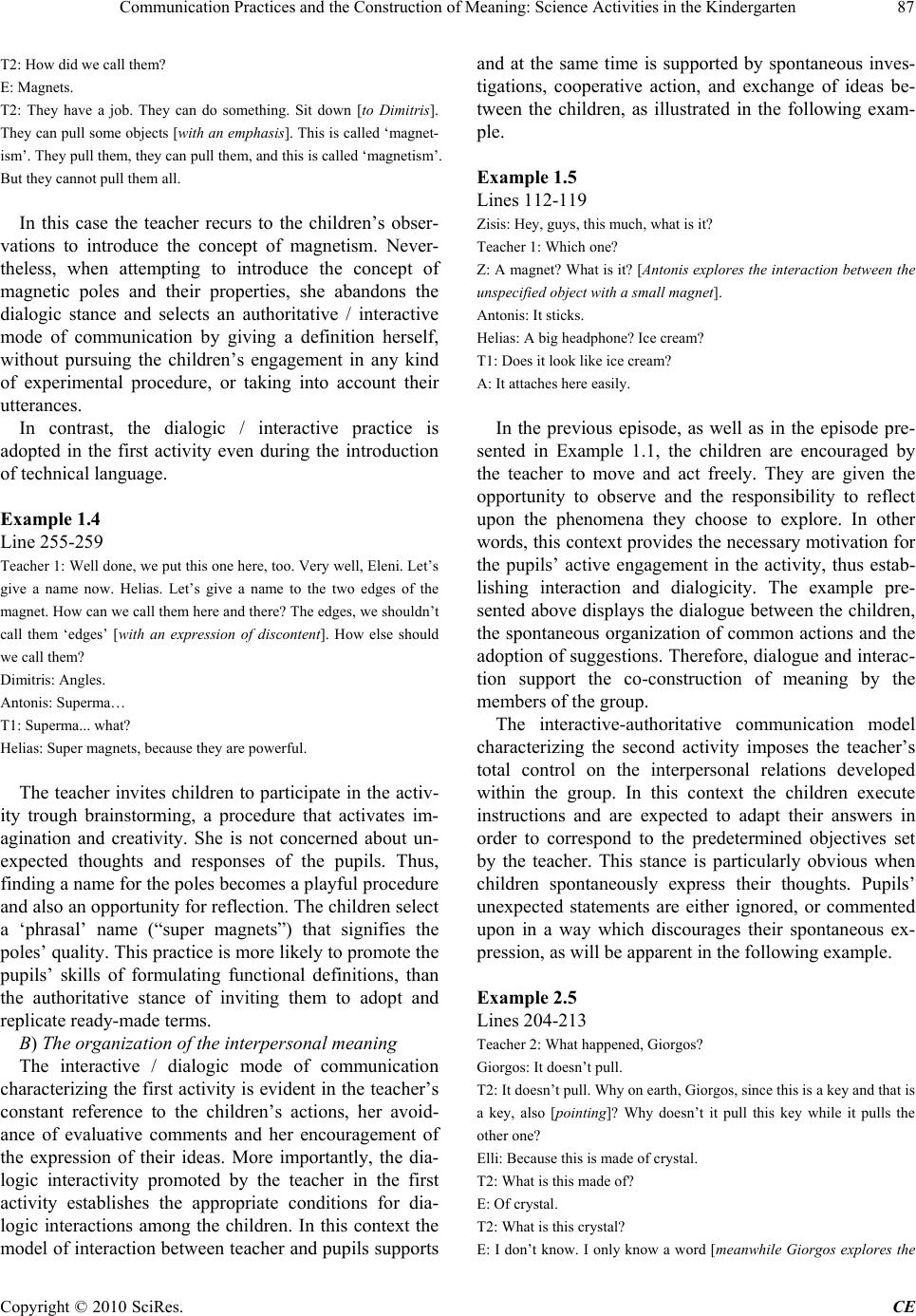 Communication Practices and the Construction of Meaning: Science Activities in the Kindergarten Copyright © 2010 SciRes. CE 87 T2: How did we call them? Ε: Magnets. T2: They have a job. They can do something. Sit down [to Dimitris]. They can pull some objects [with an emphasis]. This is called ‘magnet- ism’. They pull them, they can pull them, and this is called ‘magnetism’. But they cannot pull them all. In this case the teacher recurs to the children’s obser- vations to introduce the concept of magnetism. Never- theless, when attempting to introduce the concept of magnetic poles and their properties, she abandons the dialogic stance and selects an authoritative / interactive mode of communication by giving a definition herself, without pursuing the children’s engagement in any kind of experimental procedure, or taking into account their utterances. In contrast, the dialogic / interactive practice is adopted in the first activity even during the introduction of technical language. Example 1.4 Line 255-259 Teacher 1: Well done, we put this one here, too. Very well, Eleni. Let’s give a name now. Helias. Let’s give a name to the two edges of the magnet. How can we call them here and there? The edges, we shouldn’t call them ‘edges’ [with an expression of discontent]. How else should we call them? Dimitris: Angles. Antonis: Superma… T1: Superma... what? Helias: Super magnets, because they are powerful. The teacher invites children to participate in the activ- ity trough brainstorming, a procedure that activates im- agination and creativity. She is not concerned about un- expected thoughts and responses of the pupils. Thus, finding a name for the poles becomes a playful procedure and also an opportunity for reflection. The children select a ‘phrasal’ name (“super magnets”) that signifies the poles’ quality. This practice is more likely to promote the pupils’ skills of formulating functional definitions, than the authoritative stance of inviting them to adopt and replicate ready-made terms. B) The organization of the interpersonal meaning The interactive / dialogic mode of communication characterizing the first activity is evident in the teacher’s constant reference to the children’s actions, her avoid- ance of evaluative comments and her encouragement of the expression of their ideas. More importantly, the dia- logic interactivity promoted by the teacher in the first activity establishes the appropriate conditions for dia- logic interactions among the children. In this context the model of interaction between teacher and pupils supports and at the same time is supported by spontaneous inves- tigations, cooperative action, and exchange of ideas be- tween the children, as illustrated in the following exam- ple. Example 1.5 Lines 112-119 Zisis: Hey, guys, this much, what is it? Teacher 1: Which one? Z: A magnet? What is it? [Antonis explores the interaction between the unspecified object with a small magnet]. Αntonis: It sticks. Helias: A big headphone? Ice cream? T1: Does it look like ice cream? A: It attaches here easily. In the previous episode, as well as in the episode pre- sented in Example 1.1, the children are encouraged by the teacher to move and act freely. They are given the opportunity to observe and the responsibility to reflect upon the phenomena they choose to explore. In other words, this context provides the necessary motivation for the pupils’ active engagement in the activity, thus estab- lishing interaction and dialogicity. The example pre- sented above displays the dialogue between the children, the spontaneous organization of common actions and the adoption of suggestions. Therefore, dialogue and interac- tion support the co-construction of meaning by the members of the group. The interactive-authoritative communication model characterizing the second activity imposes the teacher’s total control on the interpersonal relations developed within the group. In this context the children execute instructions and are expected to adapt their answers in order to correspond to the predetermined objectives set by the teacher. This stance is particularly obvious when children spontaneously express their thoughts. Pupils’ unexpected statements are either ignored, or commented upon in a way which discourages their spontaneous ex- pression, as will be apparent in the following example. Example 2.5 Lines 204-213 Teacher 2: What happened, Giorgos? Giorgos: It doesn’t pull. T2: It doesn’t pull. Why on earth, Giorgos, since this is a key and that is a key, also [pointing]? Why doesn’t it pull this key while it pulls the other one? Elli: Because this is made of crystal. T2: What is this made of? E: Of crystal. T2: What is this crystal? E: I don’t know. I only know a word [meanwhile Giorgos explores the 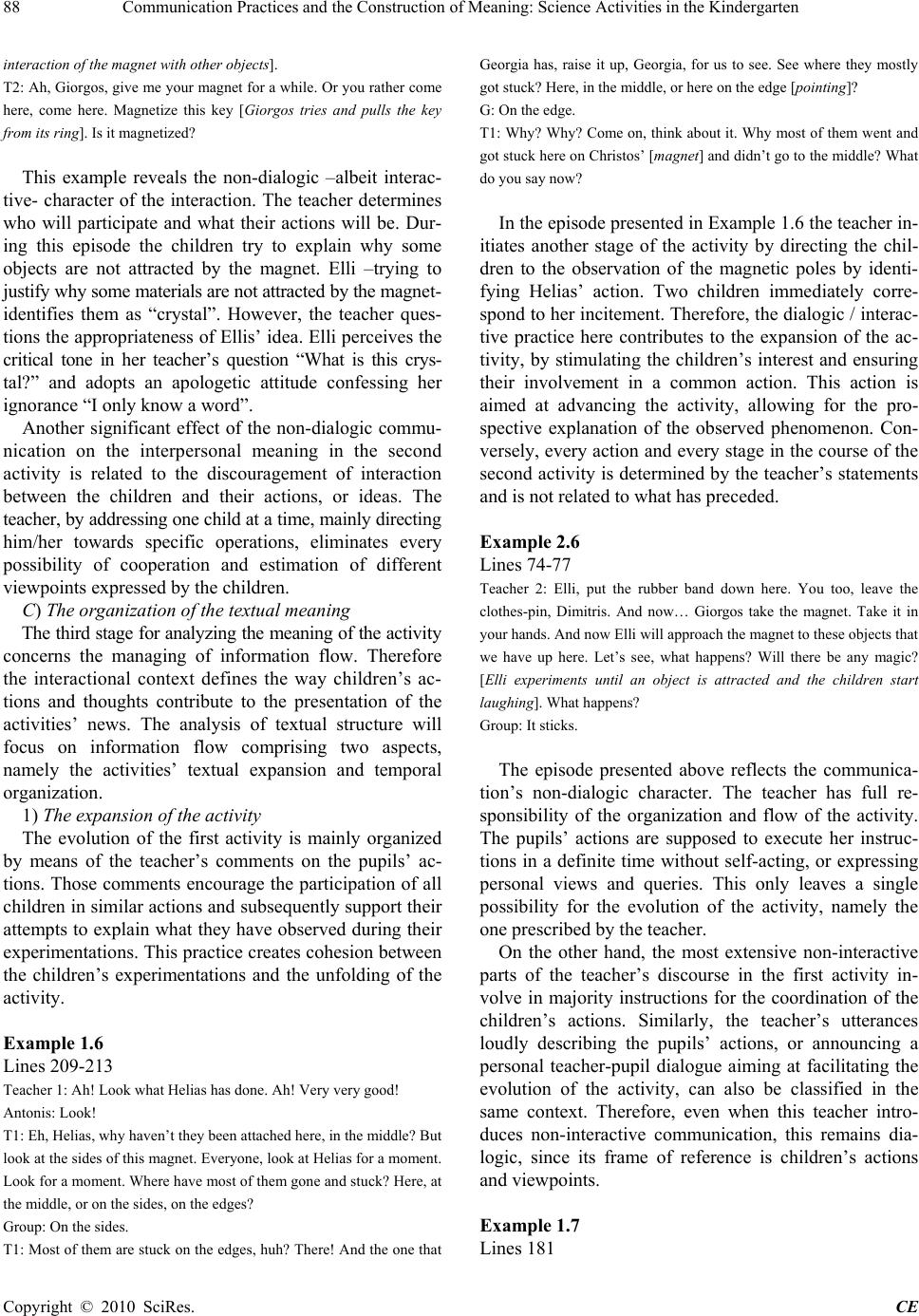 Communication Practices and the Construction of Meaning: Science Activities in the Kindergarten Copyright © 2010 SciRes. CE 88 interaction of the magnet with other objects]. T2: Ah, Giorgos, give me your magnet for a while. Or you rather come here, come here. Magnetize this key [Giorgos tries and pulls the key from its ring]. Is it magnetized? This example reveals the non-dialogic –albeit interac- tive- character of the interaction. The teacher determines who will participate and what their actions will be. Dur- ing this episode the children try to explain why some objects are not attracted by the magnet. Elli –trying to justify why some materials are not attracted by the magnet- identifies them as “crystal”. However, the teacher ques- tions the appropriateness of Ellis’ idea. Elli perceives the critical tone in her teacher’s question “What is this crys- tal?” and adopts an apologetic attitude confessing her ignorance “I only know a word”. Another significant effect of the non-dialogic commu- nication on the interpersonal meaning in the second activity is related to the discouragement of interaction between the children and their actions, or ideas. The teacher, by addressing one child at a time, mainly directing him/her towards specific operations, eliminates every possibility of cooperation and estimation of different viewpoints expressed by the children. C) The organization of the textual meaning The third stage for analyzing the meaning of the activity concerns the managing of information flow. Therefore the interactional context defines the way children’s ac- tions and thoughts contribute to the presentation of the activities’ news. The analysis of textual structure will focus on information flow comprising two aspects, namely the activities’ textual expansion and temporal organization. 1) The expansion of the activity The evolution of the first activity is mainly organized by means of the teacher’s comments on the pupils’ ac- tions. Those comments encourage the participation of all children in similar actions and subsequently support their attempts to explain what they have observed during their experimentations. This practice creates cohesion between the children’s experimentations and the unfolding of the activity. Example 1.6 Lines 209-213 Teacher 1: Ah! Look what Helias has done. Ah! Very very good! Antonis: Look! T1: Eh, Helias, why haven’t they been attached here, in the middle? But look at the sides of this magnet. Everyone, look at Helias for a moment. Look for a moment. Where have most of them gone and stuck? Here, at the middle, or on the sides, on the edges? Group: On the sides. T1: Most of them are stuck on the edges, huh? There! And the one that Georgia has, raise it up, Georgia, for us to see. See where they mostly got stuck? Here, in the middle, or here on the edge [pointing]? G: On the edge. T1: Why? Why? Come on, think about it. Why most of them went and got stuck here on Christos’ [magnet] and didn’t go to the middle? What do you say now? In the episode presented in Example 1.6 the teacher in- itiates another stage of the activity by directing the chil- dren to the observation of the magnetic poles by identi- fying Helias’ action. Two children immediately corre- spond to her incitement. Therefore, the dialogic / interac- tive practice here contributes to the expansion of the ac- tivity, by stimulating the children’s interest and ensuring their involvement in a common action. This action is aimed at advancing the activity, allowing for the pro- spective explanation of the observed phenomenon. Con- versely, every action and every stage in the course of the second activity is determined by the teacher’s statements and is not related to what has preceded. Example 2.6 Lines 74-77 Teacher 2: Elli, put the rubber band down here. You too, leave the clothes-pin, Dimitris. And now… Giorgos take the magnet. Take it in your hands. And now Elli will approach the magnet to these objects that we have up here. Let’s see, what happens? Will there be any magic? [Elli experiments until an object is attracted and the children start laughing]. What happens? Group: It sticks. The episode presented above reflects the communica- tion’s non-dialogic character. The teacher has full re- sponsibility of the organization and flow of the activity. The pupils’ actions are supposed to execute her instruc- tions in a definite time without self-acting, or expressing personal views and queries. This only leaves a single possibility for the evolution of the activity, namely the one prescribed by the teacher. On the other hand, the most extensive non-interactive parts of the teacher’s discourse in the first activity in- volve in majority instructions for the coordination of the children’s actions. Similarly, the teacher’s utterances loudly describing the pupils’ actions, or announcing a personal teacher-pupil dialogue aiming at facilitating the evolution of the activity, can also be classified in the same context. Therefore, even when this teacher intro- duces non-interactive communication, this remains dia- logic, since its frame of reference is children’s actions and viewpoints. Example 1.7 Lines 181 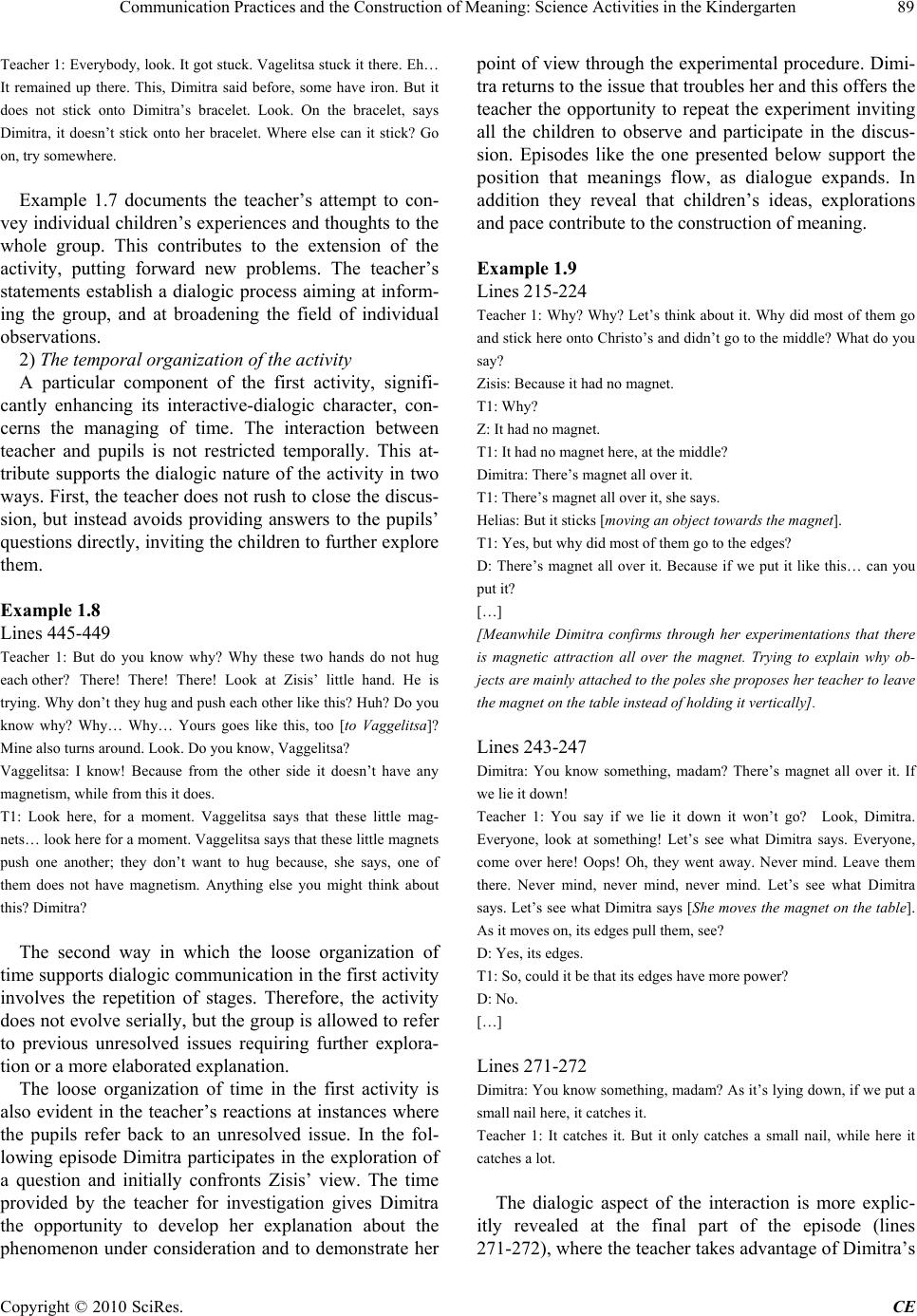 Communication Practices and the Construction of Meaning: Science Activities in the Kindergarten Copyright © 2010 SciRes. CE 89 Teacher 1: Everybody, look. It got stuck. Vagelitsa stuck it there. Eh… It remained up there. This, Dimitra said before, some have iron. But it does not stick onto Dimitra’s bracelet. Look. On the bracelet, says Dimitra, it doesn’t stick onto her bracelet. Where else can it stick? Go on, try somewhere. Example 1.7 documents the teacher’s attempt to con- vey individual children’s experiences and thoughts to the whole group. This contributes to the extension of the activity, putting forward new problems. The teacher’s statements establish a dialogic process aiming at inform- ing the group, and at broadening the field of individual observations. 2) The temporal organization of the activity A particular component of the first activity, signifi- cantly enhancing its interactive-dialogic character, con- cerns the managing of time. The interaction between teacher and pupils is not restricted temporally. This at- tribute supports the dialogic nature of the activity in two ways. First, the teacher does not rush to close the discus- sion, but instead avoids providing answers to the pupils’ questions directly, inviting the children to further explore them. Example 1.8 Lines 445-449 Teacher 1: But do you know why? Why these two hands do not hug each other? There! There! There! Look at Zisis’ little hand. He is trying. Why don’t they hug and push each other like this? Huh? Do you know why? Why… Why… Yours goes like this, too [to Vaggelitsa]? Mine also turns around. Look. Do you know, Vaggelitsa? Vaggelitsa: I know! Because from the other side it doesn’t have any magnetism, while from this it does. T1: Look here, for a moment. Vaggelitsa says that these little mag- nets… look here for a moment. Vaggelitsa says that these little magnets push one another; they don’t want to hug because, she says, one of them does not have magnetism. Anything else you might think about this? Dimitra? The second way in which the loose organization of time supports dialogic communication in the first activity involves the repetition of stages. Therefore, the activity does not evolve serially, but the group is allowed to refer to previous unresolved issues requiring further explora- tion or a more elaborated explanation. The loose organization of time in the first activity is also evident in the teacher’s reactions at instances where the pupils refer back to an unresolved issue. In the fol- lowing episode Dimitra participates in the exploration of a question and initially confronts Zisis’ view. The time provided by the teacher for investigation gives Dimitra the opportunity to develop her explanation about the phenomenon under consideration and to demonstrate her point of view through the experimental procedure. Dimi- tra returns to the issue that troubles her and this offers the teacher the opportunity to repeat the experiment inviting all the children to observe and participate in the discus- sion. Episodes like the one presented below support the position that meanings flow, as dialogue expands. In addition they reveal that children’s ideas, explorations and pace contribute to the construction of meaning. Example 1.9 Lines 215-224 Teacher 1: Why? Why? Let’s think about it. Why did most of them go and stick here onto Christo’s and didn’t go to the middle? What do you say? Zisis: Because it had no magnet. T1: Why? Ζ: It had no magnet. T1: It had no magnet here, at the middle? Dimitra: There’s magnet all over it. T1: There’s magnet all over it, she says. Helias: But it sticks [moving an object towards the magnet]. T1: Yes, but why did most of them go to the edges? D: There’s magnet all over it. Because if we put it like this… can you put it? […] [Meanwhile Dimitra confirms through her experimentations that there is magnetic attraction all over the magnet. Trying to explain why ob- jects are mainly attached to the poles she proposes her teacher to leave the magnet on the table instead of holding it vertically]. Lines 243-247 Dimitra: You know something, madam? There’s magnet all over it. If we lie it down! Teacher 1: You say if we lie it down it won’t go? Look, Dimitra. Everyone, look at something! Let’s see what Dimitra says. Everyone, come over here! Oops! Oh, they went away. Never mind. Leave them there. Never mind, never mind, never mind. Let’s see what Dimitra says. Let’s see what Dimitra says [She moves the magnet on the table]. As it moves on, its edges pull them, see? D: Yes, its edges. T1: So, could it be that its edges have more power? D: No. […] Lines 271-272 Dimitra: You know something, madam? As it’s lying down, if we put a small nail here, it catches it. Teacher 1: It catches it. But it only catches a small nail, while here it catches a lot. The dialogic aspect of the interaction is more explic- itly revealed at the final part of the episode (lines 271-272), where the teacher takes advantage of Dimitra’s 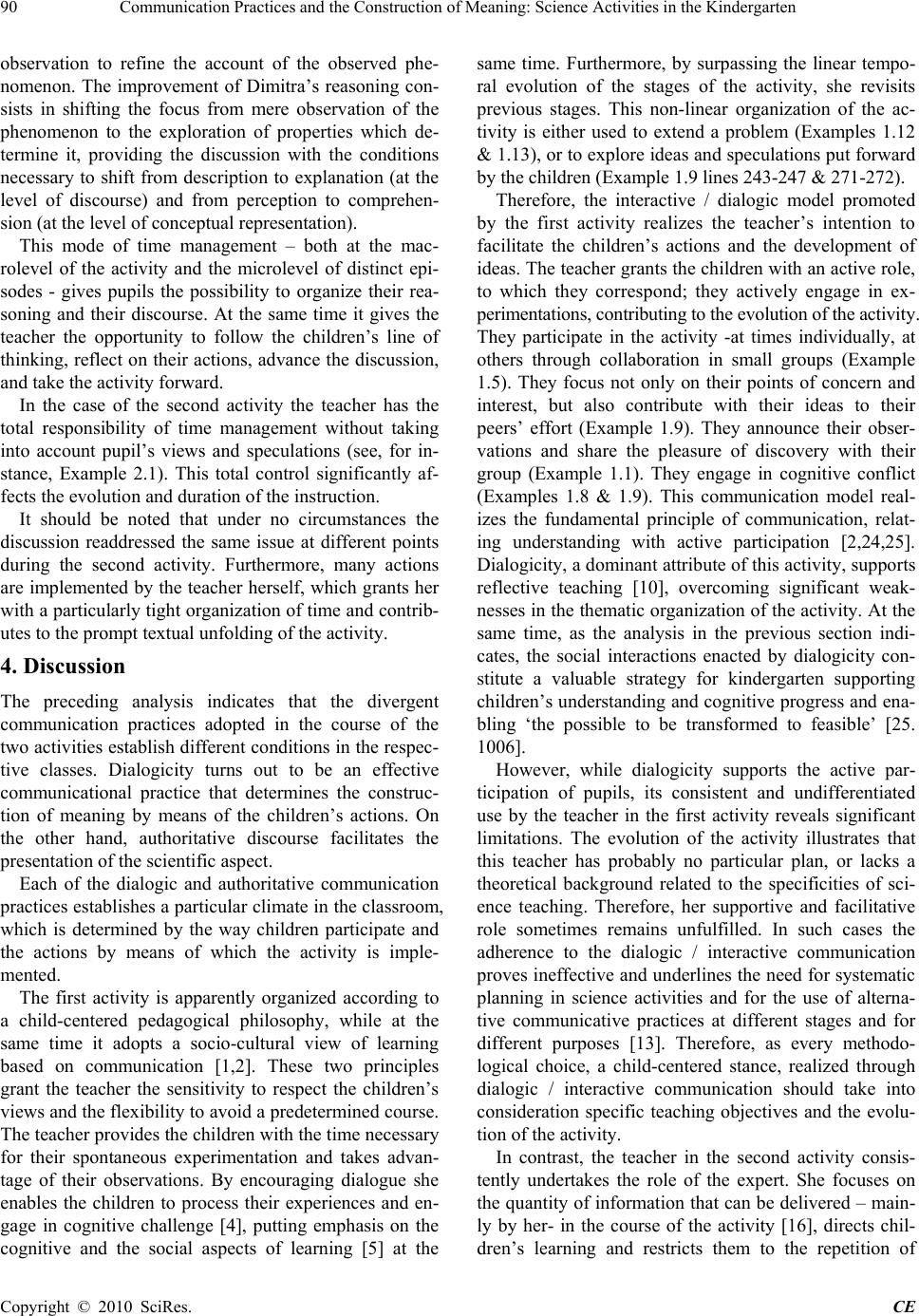 Communication Practices and the Construction of Meaning: Science Activities in the Kindergarten Copyright © 2010 SciRes. CE 90 observation to refine the account of the observed phe- nomenon. The improvement of Dimitra’s reasoning con- sists in shifting the focus from mere observation of the phenomenon to the exploration of properties which de- termine it, providing the discussion with the conditions necessary to shift from description to explanation (at the level of discourse) and from perception to comprehen- sion (at the level of conceptual representation). This mode of time management – both at the mac- rolevel of the activity and the microlevel of distinct epi- sodes - gives pupils the possibility to organize their rea- soning and their discourse. At the same time it gives the teacher the opportunity to follow the children’s line of thinking, reflect on their actions, advance the discussion, and take the activity forward. In the case of the second activity the teacher has the total responsibility of time management without taking into account pupil’s views and speculations (see, for in- stance, Example 2.1). This total control significantly af- fects the evolution and duration of the instruction. It should be noted that under no circumstances the discussion readdressed the same issue at different points during the second activity. Furthermore, many actions are implemented by the teacher herself, which grants her with a particularly tight organization of time and contrib- utes to the prompt textual unfolding of the activity. 4. Discussion The preceding analysis indicates that the divergent communication practices adopted in the course of the two activities establish different conditions in the respec- tive classes. Dialogicity turns out to be an effective communicational practice that determines the construc- tion of meaning by means of the children’s actions. On the other hand, authoritative discourse facilitates the presentation of the scientific aspect. Each of the dialogic and authoritative communication practices establishes a particular climate in the classroom, which is determined by the way children participate and the actions by means of which the activity is imple- mented. The first activity is apparently organized according to a child-centered pedagogical philosophy, while at the same time it adopts a socio-cultural view of learning based on communication [1,2]. These two principles grant the teacher the sensitivity to respect the children’s views and the flexibility to avoid a predetermined course. The teacher provides the children with the time necessary for their spontaneous experimentation and takes advan- tage of their observations. By encouraging dialogue she enables the children to process their experiences and en- gage in cognitive challenge [4], putting emphasis on the cognitive and the social aspects of learning [5] at the same time. Furthermore, by surpassing the linear tempo- ral evolution of the stages of the activity, she revisits previous stages. This non-linear organization of the ac- tivity is either used to extend a problem (Examples 1.12 & 1.13), or to explore ideas and speculations put forward by the children (Example 1.9 lines 243-247 & 271-272). Therefore, the interactive / dialogic model promoted by the first activity realizes the teacher’s intention to facilitate the children’s actions and the development of ideas. The teacher grants the children with an active role, to which they correspond; they actively engage in ex- perimentations, contributing to the evolution of the activity. They participate in the activity -at times individually, at others through collaboration in small groups (Example 1.5). They focus not only on their points of concern and interest, but also contribute with their ideas to their peers’ effort (Example 1.9). They announce their obser- vations and share the pleasure of discovery with their group (Example 1.1). They engage in cognitive conflict (Examples 1.8 & 1.9). This communication model real- izes the fundamental principle of communication, relat- ing understanding with active participation [2,24,25]. Dialogicity, a dominant attribute of this activity, supports reflective teaching [10], overcoming significant weak- nesses in the thematic organization of the activity. At the same time, as the analysis in the previous section indi- cates, the social interactions enacted by dialogicity con- stitute a valuable strategy for kindergarten supporting children’s understanding and cognitive progress and ena- bling ‘the possible to be transformed to feasible’ [25. 1006]. However, while dialogicity supports the active par- ticipation of pupils, its consistent and undifferentiated use by the teacher in the first activity reveals significant limitations. The evolution of the activity illustrates that this teacher has probably no particular plan, or lacks a theoretical background related to the specificities of sci- ence teaching. Therefore, her supportive and facilitative role sometimes remains unfulfilled. In such cases the adherence to the dialogic / interactive communication proves ineffective and underlines the need for systematic planning in science activities and for the use of alterna- tive communicative practices at different stages and for different purposes [13]. Therefore, as every methodo- logical choice, a child-centered stance, realized through dialogic / interactive communication should take into consideration specific teaching objectives and the evolu- tion of the activity. In contrast, the teacher in the second activity consis- tently undertakes the role of the expert. She focuses on the quantity of information that can be delivered – main- ly by her- in the course of the activity [16], directs chil- dren’s learning and restricts them to the repetition of  Communication Practices and the Construction of Meaning: Science Activities in the Kindergarten Copyright © 2010 SciRes. CE 91 technical terminology and expressions [17]. This is par- ticularly evident when she introduces a definition (Ex- ample 2.4 line 141). Such episodes constitute functional and essential parts of science activities. However, the authoritative / interactive communication practice perva- sively used during the second activity deprives the chil- dren from the possibility to participate in the production of classroom discourse that would have brought out in- dications of their understanding and of the effectiveness of communication [2]. Moreover, the authoritative interaction promoted dur- ing the second activity places the teacher in a strikingly privileged position in relation to the pupils, and allows her to determine the organization and evolution of the activity, as well as the children’s role in the whole proc- ess. This model of one-way communication, which builds on triadic dialogue [6,7], restrains the develop- ment of scientific reasoning based on the exploration of assumptions. Therefore, in the course of the second ac- tivity the children are not given the opportunity to ex- press their thoughts and in the few instances where this occurs spontaneously (Example 2.5 line 207) the teacher fails to correspond and exploit the children’s ideas relat- ing them to the experimental procedure. Even when she introduces teaching strategies (such as the cat and mouse analogy in Example 2.3 line 330), these do not serve her teaching purposes [24] but are merely used to attract the children’s interest and attention, and therefore do not contribute to understanding. Thus, this teacher only seeks passive understanding and discards the opportunity for effective communication [2]. Had this teacher included dialogicity at certain points of her instruction, her pupils would have had the opportunity to elaborate the out- comes of their experiments, draw conclusions from their actions and come up with functional definitions. Such skills of scientific thinking are not encouraged by the communication practice she adopts. 5. Conclusions The present study employed a framework of analysis for comparing communication practices and their role in the construction of meaning in two kindergarten activities about magnets and magnetic attraction. The analysis presented in the previous sections illustrates critical dis- crepancies in the discourses produced in the two classes. These different discourses directly result from the com- municative practices adopted by the two teachers. More- over, these discourses produce clearly differentiated meanings at the ideational, interpersonal, and textual level. More particularly, the differences in ideational mean- ing result from the differences in the negotiation of prac- tical experiences, the introduction and use of technical language, as well as the formulation of functional defini- tions, explanations, or conclusions. The differences in interpersonal meaning between the two activities are exemplified by the different roles adopted by the two teachers (facilitator or expert) and granted to their pupils (equivalent, active participants in the learning process, or passive executors of instructions). Last, the differences in textual meaning reflect dis- crepancies in terms of the activities’ expansion, that is the degree to which this textual organization is influ- enced by the children’s actions, or is entirely predeter- mined by the teacher. Differences in textual meaning also reflect discrepancies in terms of time managing. There- fore different levels of dialogicity impose variations in regards to the rhythm and duration on each activity, as well as in regards to its degree of temporal linearity. The preceding analysis underlines the necessity for preschool teachers to systematically design their science activities taking into account the social dimension of learning [1] and select accordingly the communicative practices most appropriate for each topic, stage, and teaching objective. It also illustrates the relative advan- tages and disadvantages of dialogic and authoritative interaction in the kindergarten, as well as the need for complementary use of the two communication practices [8,13] to fulfill different purposes related to young chil- dren’s initiation into science. REFERENCES [1] L. Vygotsky, “Mind in Society: The Development of Higher Psychological Processes,” Harvard University Press, Massachusetts, 1978. [2] M. Bakthin, “Speech Genres & Other Late Essays,” Uni- versity of Texas Press, Texas, 2002. [3] A. Duranti, “Linguistic Anthropology,” Cambridge Uni- versity Press, Cambridge, 1997. [4] S. Massey, “Teacher-Child Conversation in the Preschool Classroom,” Early Child Education Journal, Vol. 31, No. 4, 2004, pp. 227-231. [5] R. Engle and F. Conant, “Guiding Principles for Fostering Productive Disciplinary Engagement: Explaining an Emergent Argument in a Community of Learners Class- room,” Cognition Instruction, Vol. 20, No. 4, 2002, pp. 399-483. [6] J. Lemke, “Talking Science: Language, Learning and Values,” Ablex, Westport, 1990. [7] N. Mercer, “The Guided Construction of Knowledge,” Multilingual Matters, Clevedon, 1995. [8] P. Scott, “Teacher Talk and Meaning Making in Science Classrooms: A Vygotskian Analysis and Review,” Study in Scientific Education, Vol. 32, No. 1, 1998, pp. 45-80. [9] D. Rose, “Sequencing and Spacing of the Hidden Cur- riculum: How Indigenous Learners are left out of the  Communication Practices and the Construction of Meaning: Science Activities in the Kindergarten Copyright © 2010 SciRes. CE 92 Chain,” In: J. Muller, A. Morais and B. Davies, Eds., Reading Bernstein, Researching Berntein, Routledge Falmers, London, 2004, pp. 91-107. [10] E. V. Zee and J. Minstrell, “Reflective Discourse: Devel- oping Shared Understandings in a Physics Classroom,” International Journal of Science Education, Vol. 19, No. 2, 1997, pp. 209-228. [11] G. Jones, “T-Zone, Target Students and Science Class- room Interactions,” Journal of Research on Science Teaching, Vol. 27, No. 7, 1990, pp. 631-660. [12] R. Alexander, “Culture and Pedagogy: International Comparisons in Primary Education,” Blackwell, Oxford, 2001. [13] P. Scott, E. Mortimer and O. Aguiar, “The Tension Be- tween Authoritative and Dialogic Discourse: A Funda- mental Characteristic of Meaning Making in High School Science Lessons,” Science Education, Vol. 90, No. 4, 2006, pp. 605-631. [14] S. Kontos, “Preschool Teacher’s Talk, Roles, and Activ- ity Settings during Free Play,” Early Childhood Research Quarterly, Vol. 14, No. 3, 1999, pp. 363-382. [15] G. Wenner, “Relationship between Science Knowledge Levels and Beliefs toward Science Instruction Held by Preservice Elementary Teachers,” Journal of Science Education and Technology, Vol. 2, No. 3, 1993, pp. 461- 468. [16] T. Tu and W. Hsiao, “Preschool Teacher-Child Verbal Interaction in Science Teaching,” Electronic Journal of Science Education, Vol. 12, No. 2, 2008, pp. 1-15. [17] A. Tsatsaroni, K. Ravanis and A. Falaga, “Studying the Recontextualisation of Science in Pre-School Classrooms: Drawing on Bernstein’s Insights into Teaching and Learning Practices,” International Journal on Science Mathematics Education, 2004, Vol. 1, No. 4, pp. 385- 417. [18] M. A. K. Halliday and J. Martin, “Writing Science: Lit- eracy and Discursive Power,” Falmer, London, 1993. [19] M. Bakthin, “The Dialogic Imagination,” University of Texas Press, Texas, 1981. [20] J. Martin and P. White, “The Language of Evaluation: Appraisal in English,” Palgrave MacMillan, London, 2005. [21] H. Mehan, “Learning Lessons: Social Organization in the Classroom,” Havard University Press, Massachusetts, 1979. [22] M. A. K. Halliday, “An Introduction to Functional Grammar,” Arnold, London, 1994. [23] J. R. Martin and D. Rose, “Working with Discourse,” Continuum, London, 2003. [24] K. Ravanis and G. Bagakis, “Science Education in Kin- dergarten: Sociocognitive Perspecrive,” International Journal of Early Years Education, Vol. 6, No. 3, 1998, pp. 315-327. [25] K. Ravanis, D. Koliopoulos and Y. Hadjigeorgiou, “What Factors Does Friction Depend on? A Socio-Cognitive Teaching Intervention with Young Children,” Interna- tional Journal on Scientific Education, Vol. 26, No. 8, 2004, pp. 997-1007. |

